We may receive commissions when you buy through the links on our site. Full Disclaimer.
A lot of berries found in the wild are great for eating or making desserts, but on the other hand, enough poisonous ones are growing right in the wild.
You might think you are familiar with fruits of the wild, but sometimes it is safer to double-check because most times these poisonous berries look similar to the edible ones.
Therefore, you should know how to identify poison berries in the wild to avoid any form of casualties. Those pea-sized fruits are not worth the hurt they bring. If after clarifying you are still in doubt, it is better to avoid it.
If you come across a bunch of unfamiliar berries on your next trip or get lost in a part of the forest and need a little pick-me-up, you can follow these directions.
How to Identify Poison Berries In The Wild
Step 1: Inspect the plant
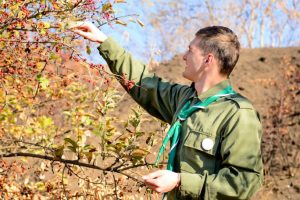
Take a crucial look at the fruits, leaves, and roots of the plant.
Gauge the length of the leaves, their branches and, the berries inspect their colors and shapes, do they grow in clusters or bunches.
What color are the unripe and ripe ones, where do they grow?
You can always bring along a book on taxonomy so you would be able to group them well.
Step 2: Check the color of the berry

Be wary of berries that are red, white, and yellow, especially if they grow in clusters, just 50% of red berries are said to be edible while blue and blackberries are usually safe to eat.
Step 3: Watch out for these features
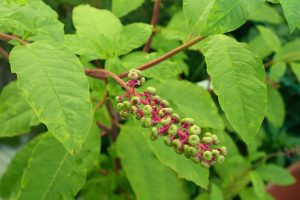
It isn’t safe to take berries from plants with milky sap, spines, hairy stems, and bitter stems, make sure to check for all these features as they all belong to harmful berries.
Step 4: Try this trick

You can take a pinch of the berry to rub on your skin or chew to check for irritation or reaction, you need to wait for about 5 minutes to see the results when you rub on your skin or lips(do not do this at the same time please, pick a step and proceed to the next). You can also chew, avoid swallowing a bit of the berry then wait for 15 minutes. Poisonous berries are most times bitter; if it tastes bitter, it is time to abort the mission.
Step 5: Eat a small quantity

If after chewing and waiting, there is no irritation and doubt you can proceed to eat just one of the berries if you are in a very needy position( no food in sight), pace the berries though, you can eat one in 15 minutes.
Step 6: Observe the symptoms
Be familiar with the symptoms of toxicity in the body, poisonous berries most times cause vomiting, shock, hallucination, and diarrhea. If any of this occurs, call a doctor or poison control.
You can also watch the video below to learn how to know the edibility of a berry.
Another method of identifying poisonous wild berries is recognition. Forehand knowledge of poisonous berries would immediately help you to know the ones to avoid, some of these berries are plants we see in gardens and houses like Jerusalem cherry and Poison Ivy while the likes of Holly and Mistletoes are used for decorations.
Here is a list of some of the poisonous wild berries we know:
Also Read: 10 Incredibly Safe Berries to Eat In The Wild
10 Poisonous Wild Berries To Avoid
1. Holly Berries
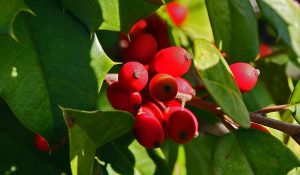
They are famous because of the Christmas season but trust me they are not giving, you have probably seen their red fruits with very green leaves on Christmas cards on signs but the best way to identify them is;
- Their glossy green leaves with prickly edges that are sharp enough to hurt you.
- The leaves sometimes have white foliage on them.
- Their berries are tiny and red growing in a scattered bunch; they could also be blue, black, white, or yellow.
- Their trees could also be round or oval.
- They sometimes grow in a shrub or become tall trees.
- They grow in moist soils and places with direct sunlight.
Birds eat Holly berries, but that doesn’t make them edible for humans. Ingesting one seed of the holly berry can cause vomiting, diarrhea, dehydration, and dizziness while ingesting up to ten seeds can be fatal. According to WebMD, they contain an inaccurate level of calcium, potassium, chloride, and magnesium, which is poisonous to the body.
2. Mistletoe Berries
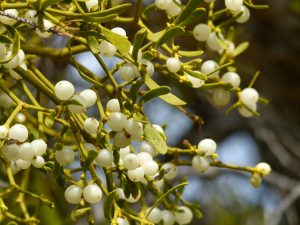
You may kiss under the mistletoe but do not let the plant or its fruits touch your mouth. They are parasitic plants that sap water from their host plants, so it isn’t unusual to see a green branch of mistletoe on a dried-up tree. We know them for their parasitic traits and:
- They attach to timbers and crop trees, which later become dry and fruitless.
- They have springy green branches with white fruits filled with a sticky pulp.
- Grow in bushes of about 2-3cm on the branches of their host plants.
- They sprout flowers before fruits; the flowers are yellow.
According to Dr. Sharon Gwantley-Brant ScienceDirect, the toxins in mistletoe can lead to cardiac depression, nausea, and vomiting. It also hurts animals too.
3. Jerusalem Cherries
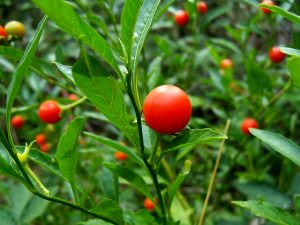
Jerusalem Cherries look very similar to tomato fruits because of the close relation of being under the same plant family, but unlike the tomato plants, these cherries are harmful to human beings and not recommended meant for eating. Gardeners grow them in homes in pots but finding them in the wild is also very possible; they grow:
- In tall shrubs.
- In moist environments with access to direct sunlight.
- Glossy dark green leaves about 3 cm long.
- Bright flowers.
- Their fruits that can be red, orange, or yellow
According to experts, the poison present in Jerusalem cherries might take time before manifesting, it roughly takes 8-10 hours, and it causes shock, diarrhea, paralysis, headache, delirium, and hallucinations.
4. Bittersweet Berries

These are creepy parasitic plants with red fruits; it is very typical to see fruits growing in several stages on the same tree. You can best identify them through:
- Their creepy shrubs with woody stems.
- Green or Purplish leaves are about 1-4 inches long; they have two small lobes at each side with a large lobe at the center.
- Star-shaped purple flowers with yellow cones
- Unripe fruits are green while ripening ones are orange and ripe, red.
- The crushed leaves have an unpleasant smell.
- They grow in moist areas with low sunlight.
Every part of this berry plant contains poison, so if you crush or touch the leaves, please do wash your hands. They are harmful to both animals and humans, and ingesting them causes gastrointestinal to disrupt.
5. Pokeweed Berries
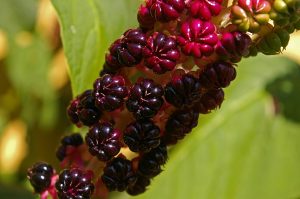
Pokeweed berries are grapelike but only tinier, and their red stems differ from the woody stems of grapes; They also leave a purple stain on the hands after picking. Pokeweed berries:
- Have taproots that are difficult to uproot
- Have tiny purple fruits grow on red spiny stems.
- Grow in shrubs with multiples stems; they also grow taller.
- They have white flowers.
Grow in moist, well-drained soils.
Every part of the pokeweed is poisonous, including its tiny fruit, which can cause severe complications like bloody diarrhea and vomiting. The sap from the plant causes dermatitis when absorbed by the skin. Do not touch this plant with your bare hands; use a glove.
6. Ivy Berries
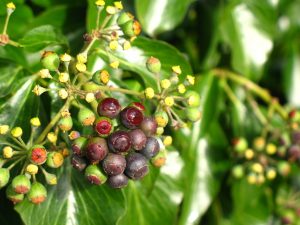
Ivy berries are creepy plants that can hang around its host up to 25ft long; This plant is for its decorative functions. The first step to identifying an ivy plant is by the itching sensation you get after touching it; the spot the plant touches becomes red and itchy. Also, you can identify this plant by:
- The reddish leaves that the young plant bears, which later become green when grown.
- Its vines, which grow fast and dominates its habitat.
- It tiny green flowers that are almost invisible if you do not pay attention; they grow in clusters on a stalk.
- White flowers with orange in the center.
- Its berries change to green while ripening to white when ripe.
- Ivy berries are fatal if ingested and do not touch the plant with bare hands.
7. Yew Berries
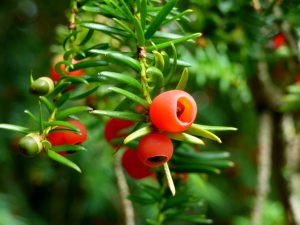
These berries have toxic seeds, the fleshy part of the berry bears no harm, but a mistake of cutting through the seeds in three cases can lead to poisoning. You can identify them by:
- Their plants grow as tall as 33 ft with thick, scaly barks that have white flakes on them.
- Leaves, which are thin, long, and green, grow symmetrically on a spine.
- Their growth in well-drained soils.
Apart from the seeds of the berries, the yew plant is also poisonous. They are fatal after ingestion.
8. Virginia Creeper Berries
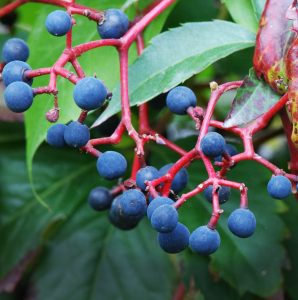
Virginia creeper berries are a part of the grape family, fruits that are purple-dark while growing in bunches make them similar to other members of the grape family. It changes color in the fall and is also a creepy plant. It climbs as high as 99ft on its host plant. The distinct features of the Virginia creeper are:
- Its leaves, which grow in fives, have been said to look familiar with ivy plants that have three lobes.
- Their small and green flowers come out in the spring.
- Their tiny hard purple-dark berries are poisonous.
Although they aren’t poisonous to birds, they stand as a significant threat to humans if ingested.
9. Moonseed
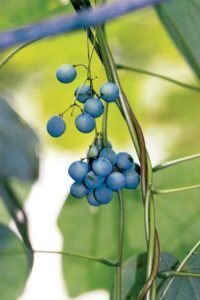
Moonseeds got their name because of their seed which looks like a crescent moon. They look like edible grapes when ripe. Identify a moonseed by:
- Creepy roots can grow very tall.
- It’s a single leaf but lobed into seven parts.
- Its growth in moist areas filled with trees.
Moonseed berries and leaves contain toxic chemicals that are fatal, remember they look so much like grapes so watch out for the crescent-shaped seeds and lack of tendrils.
10. Daphne Berries
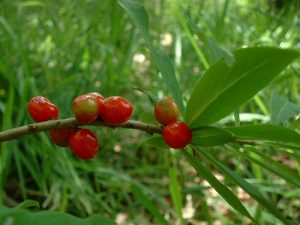
Daphne These berries are red or blue-black and grow spirally in their branch, every part of the plant, including the sap to cause gastrointestinal problems when ingested. You can identify them by:
- Their soft and glossy green leaves are thin and grow spirally on their branch.
- It grows as a shrub.
- They have purple or pink flowers.
A simple touch of the plant of the daphne berries causes rashes and eczema.
Final Words
You may see unfamiliar berries in the wild or get confused about the real edible ones. And you can safely confirm their value by avoiding berries of specific colors like red, white, and green. Also, avoid berries with plants that contain sap or any milky liquid. You can also take just one and rub it on your skin or mouth to check for irritation.
Now, you should understand how to identify poison berries in the wild and the steps to identifying them. Remember that some have leaves that irritate the skin and that most poisonous berries all have the same symptoms like nausea and vomiting. It is also great to always carry around a field guide or use this page to confirm the edibility of some berries you find in the wild. Please, do not eat berries that you do not know; it isn’t worth it.





We are a group of volunteers and opening a new scheme
in our community. Your web site provided us with useful info to work on. You have done an impressive
job and our entire neighborhood can be grateful to you.